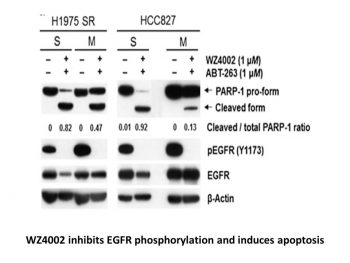
| Size | Price | Stock | Qty |
|---|---|---|---|
| 10mg |
|
||
| 25mg |
|
||
| 50mg |
|
||
| 100mg |
|
||
| 250mg |
|
||
| 500mg |
|
||
| 1g |
|
||
| Other Sizes |
Purity: ≥98%
WZ4002 (WZ-4002) is a covalent/irreversible and mutant-selective EGFR (e.g. L858R/T790M) inhibitor with potential antitumor activity. In the BaF3 cell line, it inhibits EGFR(L858R)/(T790M) with IC50s of 2 nM/8 nM.
| Targets |
EGFRL858R (IC50 = 2 nM); EGFRL858R/T790M (IC50 = 8 nM); EGFRE746_A750 (IC50 = 3 nM); EGFRE746_A750/T790M (IC50 = 2 nM)
|
|
|---|---|---|
| ln Vitro |
|
|
| ln Vivo |
|
|
| Enzyme Assay |
In vitro inhibitory enzyme kinetic assays are carried out in a 96-well format utilizing the ATP/NADH coupled assay system with recombinant EGFR L858R/T790M and WT protein. To find out how inhibiting it is, WZ4002 is added.
|
|
| Cell Assay |
EGFR delE746_A750/T790M was found to be present in the NSCLC, Ba/F3, NIH-3T3, and PC9GR4 cells through direct sequencing. The MTS assay is used in assays for cell growth and proliferation. The Quick Change Site-Directed Mutagenesis kit is used to carry out site-directed mutagenesis.
|
|
| Animal Protocol |
In order to induce the expression of mutant EGFR, cohorts of EGFR TL/CCSP-rtTA and EGFR TD/CCSP-rtTA are placed on a doxycycline diet at 5 weeks of age. After six to eight weeks on a doxycycline diet, these mice undergo MRI to record and measure the incidence of lung cancer before being assigned to different treatment study cohorts. Every treatment group consists of a minimum of three mice. Following that, mice are given either vehicle (NMP 13 (10% 1-methyl-2-pyrrolidinone: 90% PEG-300) or WZ4002 at a daily gavage dose of 25 mg/kg. These mice receive a second round of MRIs after two weeks of treatment in order to track how well the medication is working. Tumor burden measurements and MRIs are carried out.
|
|
| References | ||
| Additional Infomation |
WZ4002 is a pyrimidine compound having a 2-methoxy-4-(4-methylpiperazin-1-yl)anilino group at the 2-position, a 3-(acryloylamino)phenoxy group at the 4-position, and a chloro substituent at the 5-position. It has a role as a tyrosine kinase inhibitor and an antineoplastic agent. It is a member of pyrimidines, a member of piperazines and an organochlorine compound.
EGFR Mutant-selective Inhibitor WZ4002 is an inhibitor of the epidermal growth factor receptor (EGFR) mutant form T790M, with potential antineoplastic activity. Upon administration, EGFR mutant-selective inhibitor WZ4002 specifically targets, binds to and inhibits EGFR T790M, which prevents EGFR T790M mutant-mediated signaling and leads to cell death in EGFR T790M mutant-expressing tumor cells. EGFR, a receptor tyrosine kinase mutated in many tumor cell types, plays a key role in tumor cell proliferation and tumor vascularization. |
| Molecular Formula |
C25H27CLN6O3
|
|
|---|---|---|
| Molecular Weight |
494.18
|
|
| Exact Mass |
494.183
|
|
| Elemental Analysis |
C, 60.66; H, 5.50; Cl, 7.16; N, 16.98; O, 9.70
|
|
| CAS # |
1213269-23-8
|
|
| Related CAS # |
|
|
| PubChem CID |
44607530
|
|
| Appearance |
White to beige solid powder
|
|
| Density |
1.3±0.1 g/cm3
|
|
| Index of Refraction |
1.648
|
|
| LogP |
3.48
|
|
| Hydrogen Bond Donor Count |
2
|
|
| Hydrogen Bond Acceptor Count |
8
|
|
| Rotatable Bond Count |
8
|
|
| Heavy Atom Count |
35
|
|
| Complexity |
694
|
|
| Defined Atom Stereocenter Count |
0
|
|
| SMILES |
ClC1=C([H])N=C(N=C1OC1=C([H])C([H])=C([H])C(=C1[H])N([H])C(C([H])=C([H])[H])=O)N([H])C1C([H])=C([H])C(=C([H])C=1OC([H])([H])[H])N1C([H])([H])C([H])([H])N(C([H])([H])[H])C([H])([H])C1([H])[H]
|
|
| InChi Key |
ITTRLTNMFYIYPA-UHFFFAOYSA-N
|
|
| InChi Code |
InChI=1S/C25H27ClN6O3/c1-4-23(33)28-17-6-5-7-19(14-17)35-24-20(26)16-27-25(30-24)29-21-9-8-18(15-22(21)34-3)32-12-10-31(2)11-13-32/h4-9,14-16H,1,10-13H2,2-3H3,(H,28,33)(H,27,29,30)
|
|
| Chemical Name |
N-[3-[5-chloro-2-[2-methoxy-4-(4-methylpiperazin-1-yl)anilino]pyrimidin-4-yl]oxyphenyl]prop-2-enamide
|
|
| Synonyms |
WZ-4002; WZ 4002; WZ4002
|
|
| HS Tariff Code |
2934.99.9001
|
|
| Storage |
Powder -20°C 3 years 4°C 2 years In solvent -80°C 6 months -20°C 1 month |
|
| Shipping Condition |
Room temperature (This product is stable at ambient temperature for a few days during ordinary shipping and time spent in Customs)
|
| Solubility (In Vitro) |
|
|||
|---|---|---|---|---|
| Solubility (In Vivo) |
|
| Preparing Stock Solutions | 1 mg | 5 mg | 10 mg | |
| 1 mM | 2.0236 mL | 10.1178 mL | 20.2355 mL | |
| 5 mM | 0.4047 mL | 2.0236 mL | 4.0471 mL | |
| 10 mM | 0.2024 mL | 1.0118 mL | 2.0236 mL |
*Note: Please select an appropriate solvent for the preparation of stock solution based on your experiment needs. For most products, DMSO can be used for preparing stock solutions (e.g. 5 mM, 10 mM, or 20 mM concentration); some products with high aqueous solubility may be dissolved in water directly. Solubility information is available at the above Solubility Data section. Once the stock solution is prepared, aliquot it to routine usage volumes and store at -20°C or -80°C. Avoid repeated freeze and thaw cycles.
Calculation results
Working concentration: mg/mL;
Method for preparing DMSO stock solution: mg drug pre-dissolved in μL DMSO (stock solution concentration mg/mL). Please contact us first if the concentration exceeds the DMSO solubility of the batch of drug.
Method for preparing in vivo formulation::Take μL DMSO stock solution, next add μL PEG300, mix and clarify, next addμL Tween 80, mix and clarify, next add μL ddH2O,mix and clarify.
(1) Please be sure that the solution is clear before the addition of next solvent. Dissolution methods like vortex, ultrasound or warming and heat may be used to aid dissolving.
(2) Be sure to add the solvent(s) in order.
|
 |